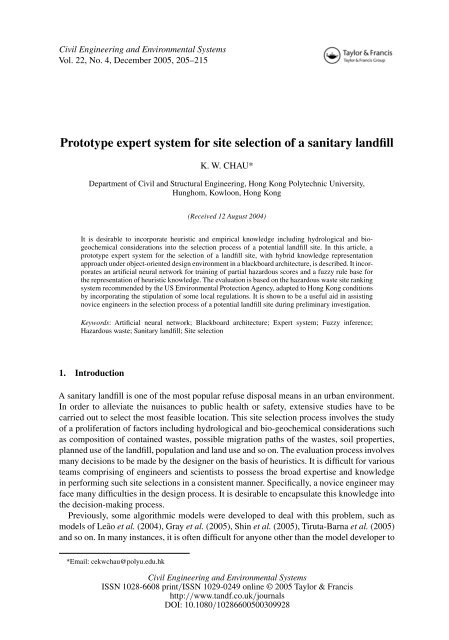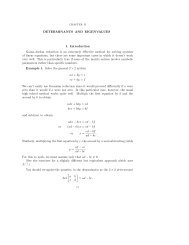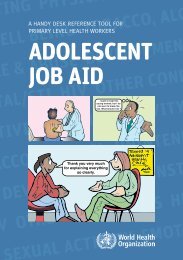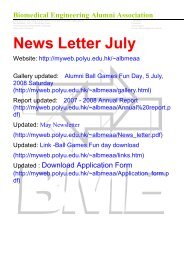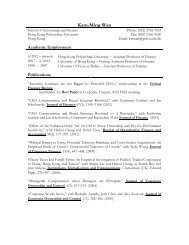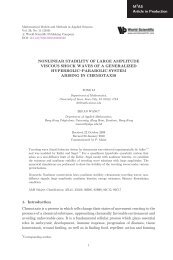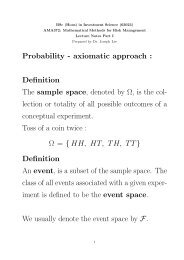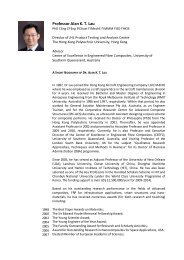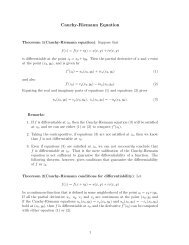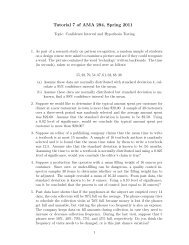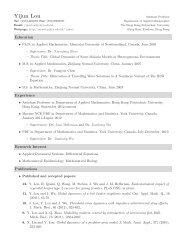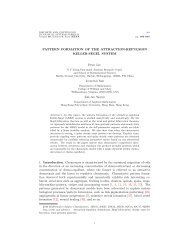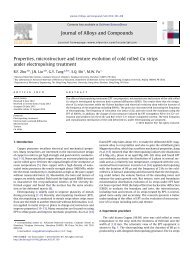Prototype expert system for site selection of a sanitary landfill
Prototype expert system for site selection of a sanitary landfill
Prototype expert system for site selection of a sanitary landfill
You also want an ePaper? Increase the reach of your titles
YUMPU automatically turns print PDFs into web optimized ePapers that Google loves.
Civil Engineering and Environmental SystemsVol. 22, No. 4, December 2005, 205–215<strong>Prototype</strong> <strong>expert</strong> <strong>system</strong> <strong>for</strong> <strong>site</strong> <strong>selection</strong> <strong>of</strong> a <strong>sanitary</strong> <strong>landfill</strong>K. W. CHAU*Department <strong>of</strong> Civil and Structural Engineering, Hong Kong Polytechnic University,Hunghom, Kowloon, Hong Kong(Received 12 August 2004)It is desirable to incorporate heuristic and empirical knowledge including hydrological and biogeochemicalconsiderations into the <strong>selection</strong> process <strong>of</strong> a potential <strong>landfill</strong> <strong>site</strong>. In this article, aprototype <strong>expert</strong> <strong>system</strong> <strong>for</strong> the <strong>selection</strong> <strong>of</strong> a <strong>landfill</strong> <strong>site</strong>, with hybrid knowledge representationapproach under object-oriented design environment in a blackboard architecture, is described. It incorporatesan artificial neural network <strong>for</strong> training <strong>of</strong> partial hazardous scores and a fuzzy rule base <strong>for</strong>the representation <strong>of</strong> heuristic knowledge. The evaluation is based on the hazardous waste <strong>site</strong> ranking<strong>system</strong> recommended by the US Environmental Protection Agency, adapted to Hong Kong conditionsby incorporating the stipulation <strong>of</strong> some local regulations. It is shown to be a useful aid in assistingnovice engineers in the <strong>selection</strong> process <strong>of</strong> a potential <strong>landfill</strong> <strong>site</strong> during preliminary investigation.Keywords: Artificial neural network; Blackboard architecture; Expert <strong>system</strong>; Fuzzy inference;Hazardous waste; Sanitary <strong>landfill</strong>; Site <strong>selection</strong>1. IntroductionA <strong>sanitary</strong> <strong>landfill</strong> is one <strong>of</strong> the most popular refuse disposal means in an urban environment.In order to alleviate the nuisances to public health or safety, extensive studies have to becarried out to select the most feasible location. This <strong>site</strong> <strong>selection</strong> process involves the study<strong>of</strong> a proliferation <strong>of</strong> factors including hydrological and bio-geochemical considerations suchas composition <strong>of</strong> contained wastes, possible migration paths <strong>of</strong> the wastes, soil properties,planned use <strong>of</strong> the <strong>landfill</strong>, population and land use and so on. The evaluation process involvesmany decisions to be made by the designer on the basis <strong>of</strong> heuristics. It is difficult <strong>for</strong> variousteams comprising <strong>of</strong> engineers and scientists to possess the broad <strong>expert</strong>ise and knowledgein per<strong>for</strong>ming such <strong>site</strong> <strong>selection</strong>s in a consistent manner. Specifically, a novice engineer mayface many difficulties in the design process. It is desirable to encapsulate this knowledge intothe decision-making process.Previously, some algorithmic models were developed to deal with this problem, such asmodels <strong>of</strong> Leão et al. (2004), Gray et al. (2005), Shin et al. (2005), Tiruta-Barna et al. (2005)and so on. In many instances, it is <strong>of</strong>ten difficult <strong>for</strong> anyone other than the model developer to*Email: cekwchau@polyu.edu.hkCivil Engineering and Environmental SystemsISSN 1028-6608 print/ISSN 1029-0249 online © 2005 Taylor & Francishttp://www.tandf.co.uk/journalsDOI: 10.1080/10286600500309928
206 K. W. Chauuse the model successfully. Moreover, heuristic knowledge is not necessarily expressed in analgorithmic manner. In fact, empirical rules, <strong>of</strong>ten being incomplete, cannot be easily placedin specific frameworks. With the advancement <strong>of</strong> artificial intelligence (AI), an <strong>expert</strong> <strong>system</strong>furnishes a solution to this decision-making process through the incorporation <strong>of</strong> symbolicknowledge processing on the basis <strong>of</strong> pertinent heuristic rules.During the past decade, the potential <strong>of</strong>AI techniques <strong>for</strong> providing assistance in the solution<strong>of</strong> engineering problems has been recognized. Expert <strong>system</strong>s are considered to be suitable <strong>for</strong>solving problems that demand considerable <strong>expert</strong>ise, judgment or rules <strong>of</strong> thumb. Areas <strong>of</strong>early applications <strong>of</strong> <strong>expert</strong> <strong>system</strong> technology include medical diagnosis, mineral explorationand chemical spectroscopy. In recent years, <strong>expert</strong> <strong>system</strong>s have been applied to emulatedomain problems in a variety <strong>of</strong> fields (Chau and Ng 1996, Ranga Rao and Sundaravadivelu1999, Chau and Chen 2001, Lin and Albermani 2001, Chau and Anson 2002, Kao and Adeli2002, Chau 2004, Chau and Albermani 2004, Yao et al. 2005). The blackboard architecture,appropriate in domains characterized by interaction between diverse knowledge sources, isone <strong>of</strong> the most popular <strong>system</strong>s in the implementation <strong>of</strong> <strong>expert</strong> <strong>system</strong>s in solving a widerange <strong>of</strong> tasks: control (Hayesroth 1985), speech recognition (Engelmore and Morgan 1988),dynamic rescheduling (Bharadwaj et al. 1994), industrial building design (Kumar 1995),interlaminar stress analysis <strong>of</strong> compo<strong>site</strong> laminates (Adeli and Yu 1995), crankshaft design(Lander et al. 1996), damage assessment <strong>of</strong> steel bridge (Barai and Pandey 2000), control <strong>of</strong> acryogenic cooling plant (Linkens et al. 2000), large space structures (Kao and Adeli 2002) andso on. However, to the best <strong>of</strong> author’s knowledge, an <strong>expert</strong> <strong>system</strong> addressing <strong>site</strong> <strong>selection</strong><strong>of</strong> a <strong>sanitary</strong> <strong>landfill</strong> has never been reported in the literature.The programming language designed <strong>for</strong> AI (LISP or PROLOG) entails tremendous programmingef<strong>for</strong>t. Nowadays, it is common in the literature that <strong>expert</strong> <strong>system</strong> shells, whichcan provide some knowledge representation methods and inference mechanisms, are used astools to facilitate the development <strong>of</strong> <strong>expert</strong> <strong>system</strong>s. This article delineates a prototype <strong>expert</strong><strong>system</strong> <strong>for</strong> the <strong>selection</strong> <strong>of</strong> a <strong>landfill</strong> <strong>site</strong>, LANDFILL, which has been developed using an<strong>expert</strong> <strong>system</strong> shell VISUAL RULE STUDIO (Rule Machines Corporation 1998) under theMicros<strong>of</strong>t Visual Basic programming environment. The blackboard architecture with hybridknowledge representation techniques including production rule <strong>system</strong> and object-orientedapproach is adopted. An artificial neural network (ANN) <strong>for</strong> training <strong>of</strong> partial hazardousscores and a fuzzy rule base <strong>for</strong> the representation <strong>of</strong> heuristic knowledge are incorporated.The <strong>expert</strong> <strong>system</strong> developed is based on the uncontrolled hazardous waste <strong>site</strong> ranking <strong>system</strong>recommended by the US Environmental Protection Agency (1984), adapted to Hong Kongconditions by incorporating the stipulation <strong>of</strong> some local regulations, including Air PollutionControl Ordinance, Waste Disposal Ordinance, Waste Disposal (Chemical Waste) (General)Regulation, Water Pollution Control Ordinance and so on. Solution strategies and developmenttechniques <strong>of</strong> the <strong>system</strong> are addressed and discussed. The innovation and original contribution<strong>of</strong> this manuscript is mainly on hybrid application <strong>of</strong> the latest AI technologies: <strong>expert</strong><strong>system</strong>; ANN; and fuzzy inference <strong>system</strong>, in this specific problem domain.2. Domain knowledgeIn general, <strong>landfill</strong>s <strong>of</strong>fer an economic and viable solution to the waste disposal problem.During the <strong>landfill</strong> operation process, engineering principles are applied to confine the refuse tothe smallest practicable size and to cover it with layers <strong>of</strong> soil cover at the end <strong>of</strong> daily operationor an interim cover at a higher frequency as appropriate. This operation requires <strong>system</strong>aticallydepositing, compacting and covering the wastes in compliance with specifications such as
<strong>Prototype</strong> <strong>expert</strong> <strong>system</strong> 207placing 150–300 mm <strong>of</strong> soil over every 600 mm <strong>of</strong> compacted fill. In addition, the soil covershould have a minimum designated depth and the final cover should be grassed to preventerosion.A common projected ultimate land use <strong>of</strong> a <strong>landfill</strong> is a park with recreational facilities,which are not affected by long-term ground subsidence.Thorough investigation has to be undertaken to select the most appropriate location <strong>for</strong> a<strong>landfill</strong> <strong>site</strong>. In the <strong>site</strong> <strong>selection</strong> process, though there may exist many more factors, four mainfactors are considered, namely potential migration routes <strong>of</strong> the wastes, waste characteristics,planned features <strong>of</strong> the <strong>landfill</strong> and potential targets at risks (Noble 1976). For potentialmigration routes, the study <strong>of</strong> contaminant movement away from the disposal <strong>site</strong> throughair, surface water and ground water is focused on. The movement <strong>of</strong> wastes depends not onlyon physical, geotechnical, geographic and environmental characteristics <strong>of</strong> the <strong>site</strong> but alsoon the waste characteristics. This feature can be quantified by its toxicity, persistence, corrosiveness,reactivity, flammability, radioactivity, solubility and volatility. The planned features<strong>of</strong> the facility will affect the degree <strong>of</strong> contamination. Potential targets subsume populationcenters, critical habitats and sensitive ecological <strong>system</strong>s in its vicinity. The knowledge canbe represented to minimize or prevent a contaminant from entering into a potential migrationroute and arriving at a potential target at risk.The <strong>site</strong> <strong>selection</strong> process involves three types <strong>of</strong> factors, namely (i) physical, geographic,climatic, soil, water quality and socioeconomic conditions; (ii) political considerations, guidelines,standards and regulations established by the pertinent authorities; and (iii) <strong>expert</strong>judgment and heuristics (US Environmental Protection Agency 1984). In this process, the<strong>expert</strong> plays a key role because an enormous <strong>expert</strong> ef<strong>for</strong>t is required in the synthesis andanalysis <strong>of</strong> these components. The following tasks are also required: designing the generalscheme and a uni<strong>for</strong>m ranking procedure, identifying constraining regulations, analyzingdata and selecting a specific <strong>landfill</strong> <strong>site</strong> together with size. The judgment and <strong>expert</strong>iseemployed by <strong>expert</strong>s in solving the domain problem are then translated into a set <strong>of</strong>explicit rules.3. LandfillLANDFILL is a prototype <strong>expert</strong> <strong>system</strong> designed to provide surrogate consultation duringpreliminary hazardous waste <strong>site</strong> investigations. It provides a versatile framework <strong>for</strong> theinterpretation, classification and diagnosis <strong>of</strong> environmental conditions at waste disposal <strong>site</strong>s.The objective <strong>of</strong> such a consultation is to obtain a <strong>site</strong> rating using the <strong>expert</strong> rules and thedecision logic described in the <strong>system</strong>’s knowledge base. The ranking criteria are based on:relative risk or danger, taking into account the population at risk; the hazardous potential <strong>of</strong> thesubstances at a facility; the potential <strong>for</strong> contamination <strong>of</strong> drinking water supplies, <strong>for</strong> directhuman contact and <strong>for</strong> destruction <strong>of</strong> sensitive eco<strong>system</strong>s; and other appropriate factors.The <strong>system</strong> is compiled and encrypted to create a run-only <strong>system</strong>. This run-only <strong>system</strong> isinstalled on a microcomputer <strong>for</strong> <strong>of</strong>fice use. The user can always overrule any options andrecommendations provided by the <strong>system</strong>. However, a mechanism is built-in to ensure thatthe user’s overruled input is reasonable and consistent. In other words, it plays the role <strong>of</strong> aknowledgeable assistant only.Besides the usual components in a typical <strong>expert</strong> <strong>system</strong>, namely, knowledge base, inferencemechanism, session context, user interface, knowledge acquisition and explanation modules,it incorporates an ANN tool, fuzzy rule <strong>system</strong> and a database. The schematic diagram <strong>of</strong> thisprototype <strong>system</strong> is shown in figure 1.
208 K. W. ChauFigure 1.Schematic diagram <strong>of</strong> the prototype <strong>expert</strong> <strong>system</strong>.3.1 Knowledge acquisition and representationKnowledge plays an important role in an <strong>expert</strong> <strong>system</strong>. The knowledge used has beenacquired from written documents such as codes <strong>of</strong> practice, textbooks and design manualsand complemented by interviews with 10 <strong>expert</strong>s, from whom fairly consistent views wereacquired within a 6-month period. In order to acquire knowledge, it is better to work with the<strong>expert</strong> in the context <strong>of</strong> solving particular problems, instead <strong>of</strong> directly posing questions aboutrules. Hybrid knowledge representation schemes, including object-oriented programming,procedural methods and production rules, are employed to express engineering heuristics and
<strong>Prototype</strong> <strong>expert</strong> <strong>system</strong> 209standard design knowledge. This approach renders it possible to take advantage <strong>of</strong> the characteristics<strong>of</strong> each method and to tailor <strong>for</strong> each type <strong>of</strong> domain knowledge in the knowledgebase.3.2 Object-oriented programmingFigure 2 shows the details <strong>of</strong> the blackboard architecture, which are classified into knowledgemodules and the blackboard. Knowledge modules corresponding to procedural <strong>expert</strong>iseknowledge are divided into decision process and process control, whereas objects in theblackboard are classified into decision stage and decision entities.The blackboard is partitioned into a number <strong>of</strong> hierarchical levels, corresponding to differentstages <strong>of</strong> the decision process. The decision stage only comprises a single object, whereas thereare several objects in the decision entities level. Data inside the decision stage are employedFigure 2.Details <strong>of</strong> the blackboard architecture.
210 K. W. Chauby the process control knowledge modules to determine the next possible action or to checkthe validity <strong>of</strong> the function triggered by the user. Forward chaining inference mechanism isemployed here to derive the next process. After a specific decision stage has been satisfied,the pertinent decision stage indicator will be assigned one <strong>of</strong> the preset values, which arenumerical values from 0 to 9.Decision process modules largely determine the scope <strong>of</strong> decision to be solved by the <strong>expert</strong><strong>system</strong>. The attached procedural method is processed when the value <strong>of</strong> the attribute changes,either by assignment under another method or by the user. A mixed problem-solving strategyis used here. The user is required merely to supply the relevant data during each decision stageand the <strong>system</strong> will determine the order in which different decision knowledge modules areexecuted.Process control modules ensure the proper and effective application <strong>of</strong> knowledge in decisionprocess modules and undertake conflict resolution. They evaluate the current attributevalues in the decision stage <strong>of</strong> the blackboard, which provides the indicator to assist thisdecision making. The main decision process class monitors the decision stage <strong>of</strong> all key tasksduring the decision process and decides either to continue to the next step or to prompt a warningmessage. All primary tasks in process control module are expressed on command buttonstogether with procedural methods attached. Process control knowledge modules work closelywith the user-interface module to produce user-friendly main menu displays. Moreover, therelevant entries and decision parameters under decision entities, the corresponding attributevalues <strong>of</strong> decision stage, are synchronized through the process control knowledge modules.3.3 Production rulesSome heuristic knowledge is represented in the IF/THEN/ELSE production rules with confidencefactors (CFs), which can be assigned either automatically or in response to the user’srequest. These rules are a <strong>for</strong>mal way <strong>of</strong> specifying how an <strong>expert</strong> reviews a condition, considersvarious possibilities and recommends an action. The explicit <strong>expert</strong>ise under the productionrule <strong>for</strong>mat in the knowledge base are employed to rank the potential <strong>landfill</strong> locations to identifythe more feasible <strong>site</strong>s <strong>for</strong> further detailed studies. The following is a typical example <strong>of</strong>the production rules.Rule to find HazardGroundwaterDepth: 1 <strong>of</strong> 8IF GroundwaterRoute.DepthOfGroundwater ≥6 ANDGroundwaterRoute.DepthOfGroundwater
<strong>Prototype</strong> <strong>expert</strong> <strong>system</strong> 211Figure 3.Fuzzy description <strong>of</strong> total population within 300 m <strong>of</strong> the <strong>site</strong> with different curves.with different curves representing the definitions <strong>of</strong> ‘very low’, ‘low’, ‘medium’, ‘high’ and‘very high’, independently. The membership functions are also set by weighted opinions <strong>of</strong>various <strong>expert</strong>s.All <strong>landfill</strong> <strong>site</strong> <strong>selection</strong> parameters are categorized into four independent types <strong>of</strong> factors,namely, groundwater route characteristics, targets at risk, facility characteristics and wastecharacteristics. The groundwater route characteristics hazard score (S gr ) considers a number<strong>of</strong> parameters including the depth <strong>of</strong> the ground water at the aquifer, net seasonal precipitation,soil permeability, physical state <strong>of</strong> the waste at the time <strong>of</strong> disposal, aquifer soil type, the depthto bedrock, geology, seismicity, faults, stratification, heterogeneity and isotropy. The targetscore (S t ), representing the level <strong>of</strong> risk to potential targets, is related to the potential use <strong>of</strong> theaquifer <strong>of</strong> concern, the vicinity <strong>of</strong> nearest production wells and nearby population served bythe ground water. The executed assigned value about the planned containment characteristics<strong>of</strong> the proposed <strong>landfill</strong> facility is defined as the facility characteristics score (S fc ). The wastecharacteristics hazard score (S wc ) considers the toxicity, persistence, corrosiveness, reactivity,ignitability, radioactivity, solubility and volatility <strong>of</strong> each potential waste substance, alongwith its projected disposed quantity. The substance with the highest sum <strong>of</strong> the assignedvalues among all projected waste substances is selected as the representative waste material.The user has to choose appropriate answers to all these questions in order to assign a hazardrating score to each parameter. The <strong>expert</strong> <strong>system</strong> then matches the selected answers witheach rule, executes the appropriate ones and computes the four partial scores from an ANN.The weighted sum <strong>of</strong> executed assigned hazard values represents independent variables. Itultimately derives the overall hazard rating score <strong>of</strong> the <strong>site</strong> (S) as follows:S = w 1 S gr + w 2 S t + w 3 S fc + w 4 S wc (1)where w 1 ,w 2 ,w 3 and w 4 are the weights <strong>of</strong> the partial score, respectively, with values assignedby <strong>expert</strong> opinion after iterated cycles <strong>of</strong> training and validation <strong>of</strong> the ANN. The overall<strong>site</strong> hazard rating score is normalized between 0 and 100, which is utilized as a measure<strong>for</strong> the relative ranking <strong>of</strong> the specific <strong>site</strong>. A lower value represents a safer potential <strong>site</strong>location. The scores can be employed as a yardstick <strong>for</strong> the relative safety <strong>of</strong> different <strong>site</strong>s.In a preliminary study, locations with high scores might be eliminated as potential <strong>landfill</strong>s,whereas <strong>site</strong>s with low scores can remain <strong>for</strong> further comprehensive investigation.
212 K. W. Chau3.4 Artificial neural networkAn ANN is used as the learning mechanism to transfer engineering experience into knowledgein determining the hazard scores. The back-propagation learning algorithm is employed totrain the network <strong>for</strong> extracting knowledge from training examples (Rumelhart et al. 1994).An ANN architecture with 36 inputs (one attribute and one CF <strong>for</strong> each feature), four outputs(one <strong>for</strong> each partial score) and one hidden layer <strong>of</strong> 18 nodes is created <strong>for</strong> the problem. Thelearning control parameters, including learning rate = 1.0 and momentum factor = 0.5, arechosen to control learning process. The initial network weights are assumed with uni<strong>for</strong>mlydistributed random values from the interval −0.5 to 0.5. The S-shaped sigmoid curve, as shownin equation (2), is used as a transfer function on each neuron to represent the input–outputrelationship in the hidden layer and output layer, whereas a linear function is employed <strong>for</strong>the input layer.S(x) =11 + e −x (2)The major advantage <strong>of</strong> employing equation (2) is that it can normalize all the input data intothe range between 0 and 1, which is more manageable in terms <strong>of</strong> data interpretation. Thenormalized root-mean-square error (NRMSE) between target and output results is computedto evaluate the training per<strong>for</strong>mance. If N be the number <strong>of</strong> testing example, T ij and O ij be thetarget values and the computed value <strong>of</strong> the ith test example and jth output node, respectively,and T j be the average target value <strong>of</strong> jth output node, then the definition <strong>of</strong> the a<strong>for</strong>ementionedstatistical quantity is as follows:NRMSE =∑ Ni=1∑ 4j=1 (T ij − O ij ) 2∑ Ni=1∑ 4j=1 (T ij − T j ) 2 (3)Figure 4 shows the relationship between NRMSE and number <strong>of</strong> training cycles. It is foundthat the error rate is converged in about 30 cycles. Self-learning mechanism is accomplishedby the use <strong>of</strong> ANN. System validation is per<strong>for</strong>med by the validation process <strong>of</strong> the ANN andby comparison <strong>of</strong> the results with those by the <strong>expert</strong>s. The knowledge base is dynamic and ifmore input–output data pairs are provided by other <strong>expert</strong>s in different locations <strong>of</strong> the world,the generalization capability <strong>of</strong> the ANN will yield different output results.Figure 4.Relationship between NRMSE and number <strong>of</strong> training cycles.
<strong>Prototype</strong> <strong>expert</strong> <strong>system</strong> 2133.5 Inference engineThe inference engine controls the strategies that determine how, from where and in what ordera knowledge base draws its conclusions. It controls the <strong>selection</strong> <strong>of</strong> procedure methods andproduction rules from the knowledge base to derive a conclusion or decision context. All thedecision steps can be seen explicitly on the main screen display. The validity <strong>of</strong> the user’schoice on the preferred sequence <strong>of</strong> decision processes is checked by process control knowledgemodules, which act opportunistically upon being triggered. An event-driven inferenceprocessing mechanism is adopted, so that the ensuing action <strong>of</strong> the <strong>system</strong> will depend on theinput made by the user. For example, the factors affecting the <strong>site</strong> characteristics are considereddepending on the nature <strong>of</strong> ground in the vicinity. If rock has been selected, the user is promptedto enter whether there are any faults. If soil has been selected, the a<strong>for</strong>ementioned questionwill not be asked.After the network is trained, this <strong>system</strong> is capable <strong>of</strong> diagnozing new cases <strong>of</strong> <strong>site</strong> <strong>selection</strong>,even <strong>for</strong> the cases that some input values are unknown owing to unavailable or missing records.A hybrid reasoning strategy that combines <strong>for</strong>ward and backward reasoning schemes is usedin order to arrive at a reasonable conclusion with minimum in<strong>for</strong>mation. Forward chaininginference is employed to infer the output values given the current input values, part <strong>of</strong> whichmay be unknown initially. The prototype arrives at a conclusion when no unknown input canalter the current decision significantly. However, if the <strong>system</strong> has not yet arrived at a certainconclusion with a defined threshold value <strong>of</strong> CF, backward chaining reasoning is employed.The <strong>system</strong> automatically highlights the unknown input units, which have a significant effecton the current most plausible conclusion, and prompts the user to enter their values.3.6 User interfaceThe <strong>system</strong> <strong>of</strong>fers a user-friendly interface. Although input data entries are kept at a minimum,they are provided by the user, mostly through <strong>selection</strong> <strong>of</strong> appropriate values <strong>of</strong> parametersfrom the menus and answers to the queries made by the <strong>system</strong>. If the input data provided bythe user is not within the specified range, it will be rejected and a warning message will beprompted. The <strong>system</strong> provides a contemporary multi-window graphics text display, whichis valuable to novice engineers.4. Case exampleA case example is employed to demonstrate the application <strong>of</strong> the <strong>system</strong>. The overall <strong>landfill</strong>hazard rating <strong>of</strong> a potential rural <strong>site</strong> located at Tseng Kwan O is evaluated. User-friendlydisplays are used to interact with end-users by prompting <strong>for</strong> values and showing the outputdata. The sample run commences with inputs on various groundwater route characteristics inthe main menu. The depth <strong>of</strong> ground water to aquifer is 50 m. The soil properties are homogeneous in all directions without anystratification and there are no faults nearby. The waste is in a solid state and is unconsolidated. Itwill release an unpleasant smell with pH value <strong>of</strong> 8. The waste is flammable and its temperatureis
214 K. W. ChauFigure 5.Screen displaying overall <strong>landfill</strong> <strong>site</strong> hazard rating score.the nearest drinking water well is ∼200 m. The <strong>system</strong> trans<strong>for</strong>ms these production rules intouser-friendly interactive menus. On the basis <strong>of</strong> the responses <strong>of</strong> the user, the <strong>system</strong> searchesthe knowledge base and generates the overall <strong>landfill</strong> <strong>site</strong> rating score, which is shown infigure 5. In general, a range <strong>of</strong> scores between 0 and 50 would indicate a <strong>site</strong> to be feasible<strong>for</strong> <strong>sanitary</strong> <strong>landfill</strong>. In this case, the score <strong>of</strong> 41 is <strong>of</strong> medium value and it is feasible as a<strong>site</strong> <strong>for</strong> <strong>sanitary</strong> <strong>landfill</strong>. The recommendation is that detailed investigations can be furtherundertaken, which was verified by independent but consistent assessments <strong>of</strong> <strong>expert</strong>s.5. ConclusionsThe integration <strong>of</strong> the heuristic and empirical knowledge into a decision support <strong>system</strong> isuseful in the <strong>selection</strong> process <strong>of</strong> a potential <strong>landfill</strong> <strong>site</strong>, because a simple score can represent adiversity <strong>of</strong> complicated factors. A prototype <strong>expert</strong> <strong>system</strong>, which assists in making decisionson <strong>selection</strong> <strong>of</strong> an appropriate <strong>landfill</strong> <strong>site</strong>, was developed and implemented. It incorporatesan ANN <strong>for</strong> training <strong>of</strong> partial hazardous scores and a fuzzy rule base <strong>for</strong> representation <strong>of</strong> theheuristic knowledge. It is shown that the hybrid application <strong>of</strong> these latest AI technologies isappropriate to act as storage <strong>for</strong> empirical knowledge, so that advice on <strong>landfill</strong> <strong>site</strong> <strong>selection</strong>can be furnished in the preliminary design stage. The evaluation <strong>of</strong> the prototype <strong>system</strong> isbased on the hazardous waste <strong>site</strong> ranking <strong>system</strong> recommended by the US EnvironmentalProtection Agency, adapted to Hong Kong conditions by incorporating the stipulation <strong>of</strong> somelocal regulations. The knowledge base is transparent and can be easily updated, which rendersthe <strong>expert</strong> <strong>system</strong> an ideal tool <strong>for</strong> incremental programming. Increase in efficiency, improvement,consistency <strong>of</strong> results and automated record keeping are among the advantages <strong>of</strong> such a
<strong>Prototype</strong> <strong>expert</strong> <strong>system</strong> 215<strong>system</strong>. Furthermore, the educational spin-<strong>of</strong>f <strong>of</strong> an <strong>expert</strong> <strong>system</strong> in training novice engineersor in transferring knowledge is significant.ReferencesAdeli, H. and Yu, G., An integrated computing environment <strong>for</strong> solution <strong>of</strong> complex engineering problems using theobject-oriented programming paradigm and a blackboard architecture. Comp. Struct., 1995, 54(2), 255–265.Barai, S.V. and Pandey, P.C., Integration <strong>of</strong> damage assessment paradigms <strong>of</strong> steel bridges on a blackboard architecture.Expert Syst. Appl., 2000, 19(3), 193–207.Bharadwaj, A., Vinze, A.S. and Sen, A., Blackboard architecture <strong>for</strong> reactive scheduling. Expert Syst. Appl., 1994,7(1), 55–65.Chau, K.W., A prototype knowledge-based <strong>system</strong> on unsteady open channel flow in water resources management.Water Int., 2004, 29(1), 54–60.Chau, K.W. and Albermani, F., An <strong>expert</strong> <strong>system</strong> on design <strong>of</strong> liquid-retaining structures with blackboard architecture.Expert Syst., 2004, 21(4), 183–191.Chau, K.W. and Anson, M., A knowledge-based <strong>system</strong> <strong>for</strong> construction <strong>site</strong> level facilities layout. Lecture Notes inArtificial Intelligence, 2358, 393–402, 2002 (Springer: Berlin).Chau, K.W. and Chen, W., An example <strong>of</strong> <strong>expert</strong> <strong>system</strong> on numerical modelling <strong>system</strong> in coastal processes. Adv.Eng. S<strong>of</strong>tware, 2001, 32(9), 695–703.Chau, K.W. and Ng, V., A knowledge-based <strong>expert</strong> <strong>system</strong> <strong>for</strong> design <strong>of</strong> thrust blocks <strong>for</strong> water pipelines in HongKong. J. Water Supply Res. Technol.: Aqua, 1996, 45(2), 96–99.Engelmore, R. and Morgan, T., Blackboard Systems, 1988 (Addison-Wesley: Wokingham).Gray, D., Pollard, S.J.T., Spence, L., Smith R. and Gronow, J.R., Spray irrigation <strong>of</strong> <strong>landfill</strong> leachate: estimatingpotential exposures to workers and bystanders using a modified air box model and generalised source term.Environ. Pollut., 2005, 133(3), 587–599.Hayesroth, B., A blackboard architecture <strong>for</strong> control. Artificial Intell., 1985, 26(3), 251–321.Kao, W.M. and Adeli, H., Multitasking object-oriented blackboard model <strong>for</strong> design <strong>of</strong> large space structures. Eng.Intell. Syst. Electric. Eng. Commun., 2002, 10(1), 3–8.Kumar, B., Knowledge processing <strong>for</strong> structural design, In Topics in Engineering, volume 25, edited by C.A. Brebbiaand J.J. Connor, 1995 (Computational Mechanics: Southampton).Lander, S.E., Corkill, D.D. and Staley, S.M., Designing integrated engineering environments: blackboard-basedintegration <strong>of</strong> design and analysis tools. Concurr. Eng. Res. Appl., 1996, 4(1), 59–71.Leão, S., Bishop, I. and David Evans, D., Spatial–temporal model <strong>for</strong> demand and allocation <strong>of</strong> waste <strong>landfill</strong>s ingrowing urban regions. Comp. Environ. Urban Syst., 2004, 28(4), 353–385.Lin, S. and Albermani, F., Lattice-dome design using a knowledge-based <strong>system</strong> approach. Computer-Aided CivilInfrastruct. Eng., 2001, 16(4), 268–286.Linkens, D.A., Abbod, M.F., Browne, A. and Cade, N., Intelligent control <strong>of</strong> a cryogenic cooling plant based onblackboard <strong>system</strong> architecture. ISA Trans., 2000, 39(3), 327–343.Noble, G., Sanitary Landfill Design Handbook: The Science and Art <strong>of</strong> Site Selection, Investigation, and Design,1976 (Technomic Publishing Co: Westport, CT).Ranga Rao, A.V. and Sundaravadivelu, R., A knowledge based <strong>expert</strong> <strong>system</strong> <strong>for</strong> design <strong>of</strong> berthing structures. OceanEng., 1999, 26(7), 653–673.Rule Machines Corporation, Developer’s Guide <strong>for</strong> Visual Rule Studio, 1998 (Rule Machines Corporation:Indialantic).Rumelhart, D.E., Widrow, B. and Lehr, M.A., The basic ideas in neural networks. Commun. ACM, 1994, 37(3), 87–92.Shin, H.C., Park, J.W., Kim, H.S. and Shin, E.S., Environmental and economic assessment <strong>of</strong> <strong>landfill</strong> gas electricitygeneration in Korea using LEAP model. Energy Policy, 2005, 33(10), 1261–1270.Tiruta-Barna, L., Rethy, Z. and Barna, R., Release dynamic process identification <strong>for</strong> a cement based material invarious leaching conditions. Part II. Modelling the release dynamics <strong>for</strong> different leaching conditions. J. Environ.Manag., 2005, 74(2), 127–139.US Environmental Protection Agency, Uncontrolled Hazardous Waste Site Ranking System, A User Manual, HW-10.,1984 (USEPA: Washington DC).Yao, L., Postlethwaite, I., Browne, W., Gu, D., Mar, M. and Lowes, S., Design, implementation and testing <strong>of</strong> anintelligent knowledge-based <strong>system</strong> <strong>for</strong> the supervisory control <strong>of</strong> a hot rolling mill. J. Process Control, 2005,15(6), 615–628.


